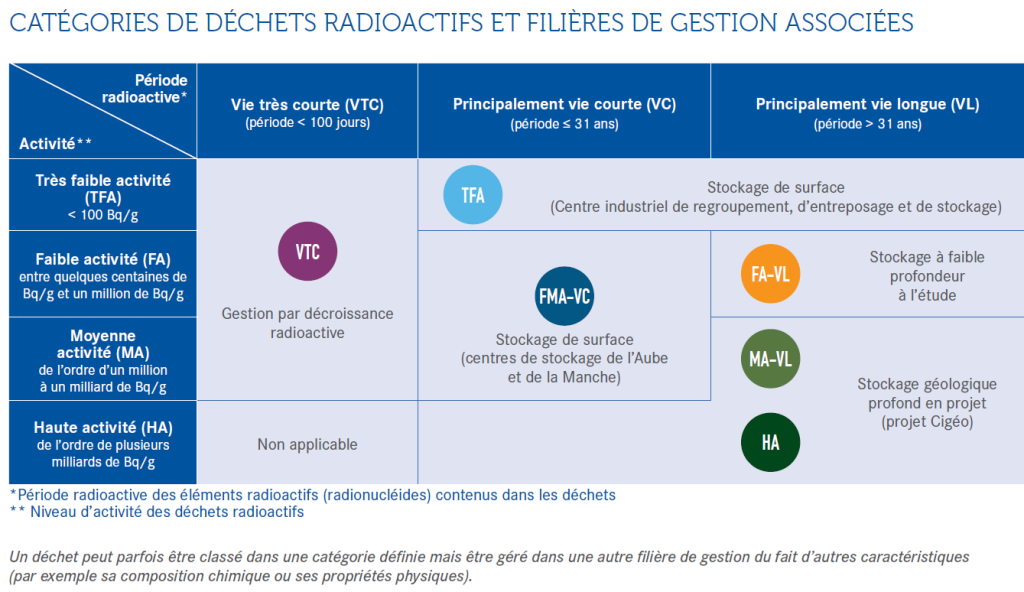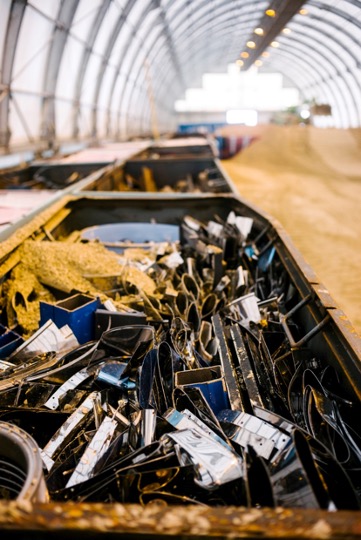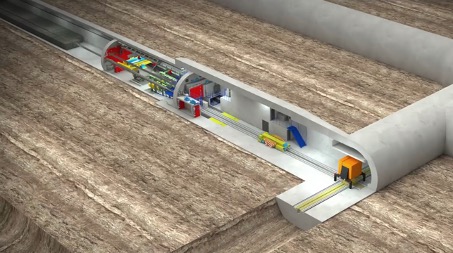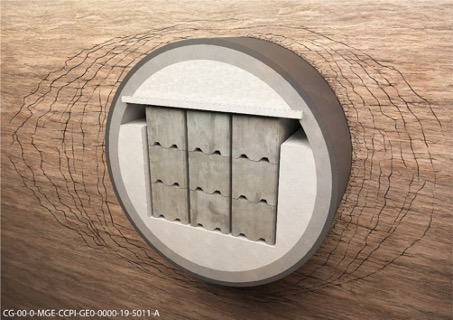Brent Frère pictures:
This 18.10.2024, we enjoyed a perfect weather for a deep underground journey…


on the limit of Meuse and Haute-Marne departments..
The surface exhibition
The surface exhibition is very interesting and does not require special arrangements, such as long-term reservation or a minimum of visitors (group), so you may consider visiting this part by your own, assuming you check their opening hours and availability.
We’ve been explained the sources of nuclear wastes, the way they are currently managed, sorted, recycled, moved, stored, …
A very interesting source of explanation is here:
https://www.encyclopedie-energie.org/gestion-dechets-radioactifs
The main sources are
- Electricity production
- Military applications
- Industrial applications
- Medical applications
- Scientific researches
- …

We’ve been explained also the different categories of nuclear wastes: short-term, long-term, low or high activity wastes, and so on…

What is important to understand is that “short-term live” wastes may be just stored until they delayed enough to be returned to normal storage, and that “low-level activity wastes” (such as computers that have been used on a nuclear power production unit site, but that are NOT radioactive) may be safely stored without very strong constraints.

What remains is less than 10% of the total nuclear wastes. It is the long or middle-long lasting wastes (from several centuries to hundredths of millenniums). They need a specific solution. In France, Orano is taking care of those products, mainly the used and not recyclable nuclear reactor fuels. After a chemical separation, they are mixed with a special kind of glass at very high temperature, and stored in metallic containers. Video.
Those containers are carried by secured dedicated shelters, on wagons. Such transports happens almost every day on the French railway network.

The dedicated wagons are designed to survive all kind of accidents, even deep falls, and the remaining radioactivity level at 1 meter, for a human staying one hour, is less than a medical X-ray exam.
For the cows watching the trains, assuming they are at a minimum distance of 5 meters, their “exposition” is lower than the natural radioactivity…
Details about such transports here: https://www.orano.group/fr/l-expertise-nucleaire/gamme-complete-de-services/transport-entreposage-et-gestion-de-la-matiere
If the Bure geological disposal facility solutions is finally retained as acceptable by the politic level, such trains will arrive at the rate of about 70 a year to Bure site. The shields will be unloaded and handled:
- toggled from horizontal to vertical
- opened
- the metallic containers will be placed in concrete blocks (for low-activity wastes) or metallic cylinders (for high-activity wastes)
- placed in a dedicated shelter
- rolled down to the storage area (12% slope, 4.5 km long ramp, down to -490 meters under the surface level)
- moved to the storage areas on rails
The descending wagon is equipped with three independent break systems, just in case of…
Down, at -490 meters, in the monolithic clay layer that has been selected for its properties, the storage shelters will be moved to their final locations a fully automatic way, on rails:
This layer has been selected because of its physic, hydraulic properties, as well as its stability. As there is no natural ressource around (gold, diamonds, oil, gaz, copper, …), it is unlikely that somebody will ever want to dig here, especially at this depth…


There are several ways to dig such tunnels, as well as to support them.
This is one of the aspects Cigéo lab is evaluating.


The actual storage will be done this way

The empty space is lower than 10%, as, with time, the entier space will be regained by the surrounding matter, due to the incredible pressure. It is important that no remaining holes would migrate progressively to the surface, causing leaking and/or questionings from the surface inhabitants.
In brown, the natural clay.
In green, the excavated tube and the concrete cylinder.
In light blue, concrete filling, leaving just the storage volume.
In purple, the concrete containers, with inside, the metallic cylinders containing the low-activity, long-life nuclear wastes.
As it is important to predict the way all this will evolve in the next millennium, real-size experiment are done now. Here, the measurement of the dimension evolution of the concrete shelters under permanent, long-lasting weight;

To handle those blocks, control their situation during the first few decades, special designed robots are engineers by various companies, such as:

For the high activity, long-live nuclear wastes, they need first to be stored in some remote, cooled area for some decades (typically 60 years) before they can find their final storage place, as the clay temperature should never become higher than 90°C. Indeed, such a temperature would change the physics of the clay, at least due to the contained water…
The high-level long-live nuclear wastes will be stored in 90 cm wide tubes, dug out in the clay, so that the heat produced by the nuclear activity will dissipate into the surrounding clay. Those tubes are 150 meter long, and some space will be left between the metallic containers.

The 150 meter long tubes will be separated from each other by a greater distance than for the low-level activity wastes, as there is a need to “dilute” the heat produced in a great amount of clay.
The heat wave should hit the surface in 700 years, and cause an average increase of the surface ground by 1°C maximum.
Special machinery has been designed to drill those holes, as well as to test them, at every level: physical properties, geometrical persistance, straight direction precision, thermal resistance, evolution with time, …


Now that we have been informed about the security measures, fitted with appropriate clouds, shoes and telecommunication devices, let’s go to…
The underground trip

The red area is the potential, planned low-activity nuclear waste storage area, so the “large tubes” structure, containing the 3-layers concrete blocks.
The orange zone is the future (if this solution is retained) high-activity storage area, so the 150 meters long thin (90 cm width) tubes. This area will contain much less material than the red one (about 10% only) but spread over a wider surface, as there is a need for a larger distance between the tubes, due to the heat produced by this kind of nuclear wastes.
Let’s take the lift…

There are currently two vertical wells, allowing fresh air circulation and escape in case of emergency or failure of one of them. There are also several lifts. One for the staff, and some for the hardware.
At first sight, the “lab” is not exactly as expected… No white lab coats. It much more looks like an intense work place !
Quite surprisingly, the light is very bright. Indeed, the choice has been to deliberately use “daylight” kind of light sources. However, almost everything looks the same colour: gray, as the surrounding clay.
And there is great chance that the cleaner team didn’t had time to come here since some years (if ever), looking at the dust layer thickness…

Our guest introduced us to the surrounding ground: this clay, that has the required physical properties to be the appropriate shelter for radioactive material for 100 to 300 thousands of years.

I’m pretty sure that some such samples, well prepared, may be sold on the Internet for a great price, as samples of Moon rocks !
Unfortunately, once bring back to the surface and cleaned, they don’t look anymore so special…

In case the lift is unavailable for any reason, hopefully, there is still the freight lift…
We have been presented the various kind of machinery that is used here to dig those… holes, basically.
Let remember the little map, down-right, as there is no “Exit” indication whatsoever… Just in case of need !

Only the hydraulic rock-breaker is still used today.
Let’s start the walk.
We are asked to stay on the yellow pads. There are numerous workers active here (more than 50) and they are driving various engines, so safety measures should be followed carefully at all times.
The place is not very large (~2 km in tunnel total length so far). There are various digging techniques that are evaluated, various coating materials, various refills. All those are watched during time, with precision, as the idea is to be able to predict the site evolution on the next centuries at least (exploitation should last at least 120 years, and the nuclear material should be removable in good shape during this time if an alternative solution is found preferable), but also hundredths of thousands of years, as those products should not harm any future civilisation, even if they don’t know this storage existence…
Larger tunnels are weaker and more difficult to maintain than smaller ones. Tests are ongoing, but it is not easy to dig large diameter (up to 12 meters and more) without large engines that are available… on the surface ! Here, such engines should be bring down in “small” parts, that fits in the lift and may be carried by humans or small devices ! Indeed, to be usable as long-term shelter for nuclear waste, the clay layer must remain as much as possible intact, so the amount and size of the holes between the surface and the installation must remain limited.
The progress of the digging must follow strict security rules, as there is always a risk of roof of wall fall. A structure is then installed to stabilise the apparent clay surface, and there are also several solutions that must be evaluated.

Notice the fire extinguisher, in case the concrete takes fire…
(actually, there are other materials than concrete in the lab)
Here is a re-fill material, made from the local dug clay, and that is evaluated in some of the tunnel. Its depth (~15 cm) gets reduced by half in the first year ! So the trend of the surrounding clay to recover the empty space left by the diggings is obvious !

A very interesting aspect of the place is that the digging, by itself, causes the clay to be damaged, to move, to develop scratches. In one direction (vertical), we have the weight of the 500 meters of ground, but in the (almost) horizontal direction, we have the combined pression of the African tectonic plate that pushes Eurasian one to the North, and the pressure due to the weight of the alpines mountains, aside. This has as consequences that the tunnel diggings causes crackings in the clay in different directions, depending on the dug tunnel direction !

As consequence, the tunnels that will contain the nuclear wastes will be dug in a precise orientation, as illustrated here, and the part of the tunnel that is close to the perpendicular (access) tunnel will not be used for storage.
What we can see here is that this “small” (90cm width) tunnel is damaged vertically in the few first meters, as it suffers from the damages caused by the drill of the main, access tunnel we are in, and suffers from horizontally scratches deeper on its length.
For the storage of the nuclear waste, as the entire storage (glass, iron cans, concrete or metal shelters, surround fillings, …) will eventually mix and migrate into the clay, it is better to create storage tubes in the direction that reduces the vertical scratches.
An interesting view of those damages can be seen here:

Various options are tried, evaluated, measured regarding the way those small sized tunnel should be drilled, maintained, filled, … As the principle is to be able to retrieve the nuclear waste metallic cans for the next 120 years at least, tests must be performed on how those hardware evolve in this time frame. This is done using, as example, hot saturated salted vapour. The metallic shelter then becomes this, after few months only:

It’s now time to (try to) find our way back to the lift, and to the surface…

A big “thanks” to our Cigéo guests, that were welcoming all kind of questions (including the stupid ones), and had answers to (almost) all of them.
A really great visit, a place that very few persons had the opportunity to visit.
Once again, thank you Andra and our guides for this astonishing trip at 500 meters downhill…
So next summer, if your baby boy likes digging in the sand,

It may means he has a future career in one of the Andra/Cigéo teams !


















